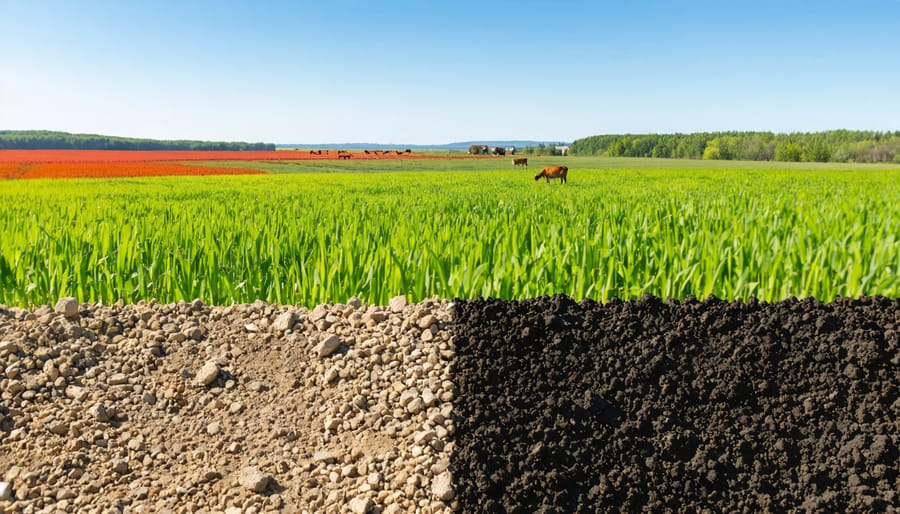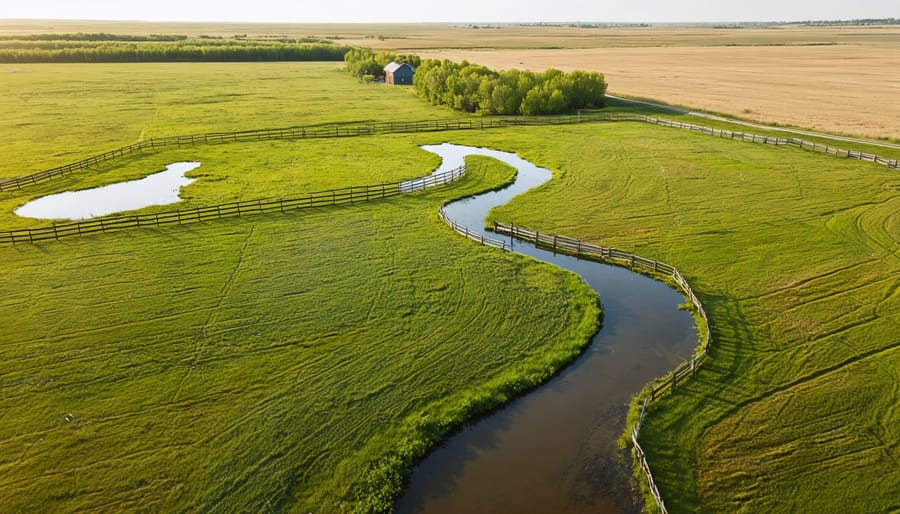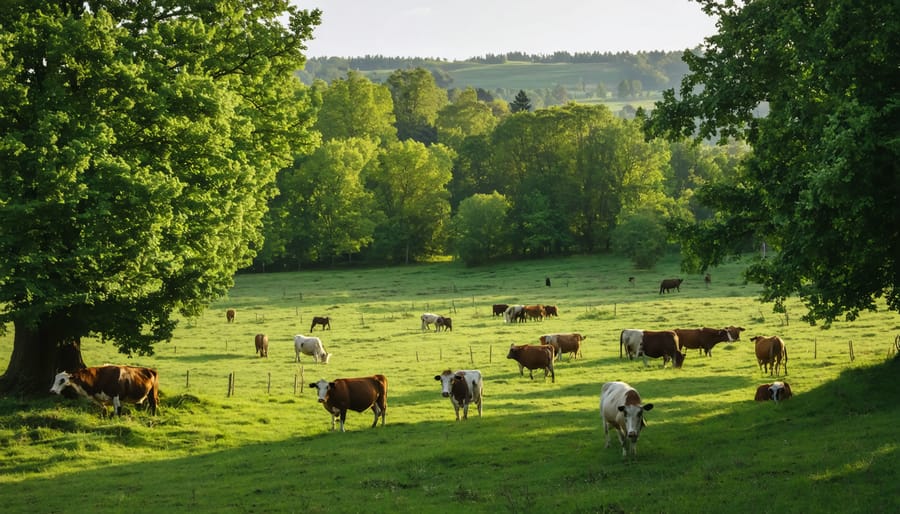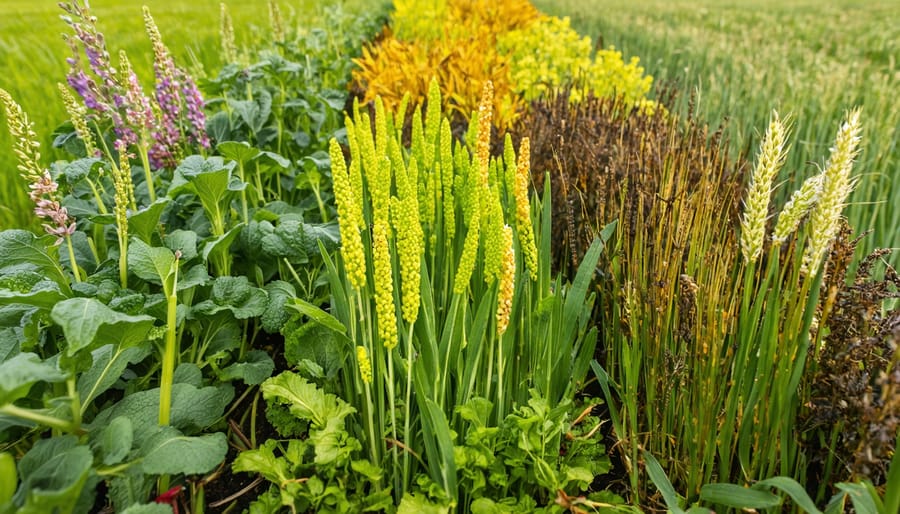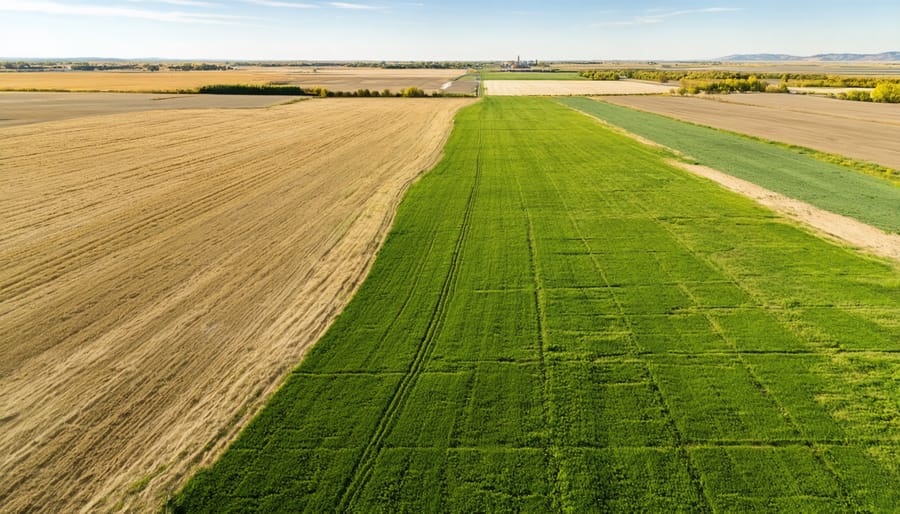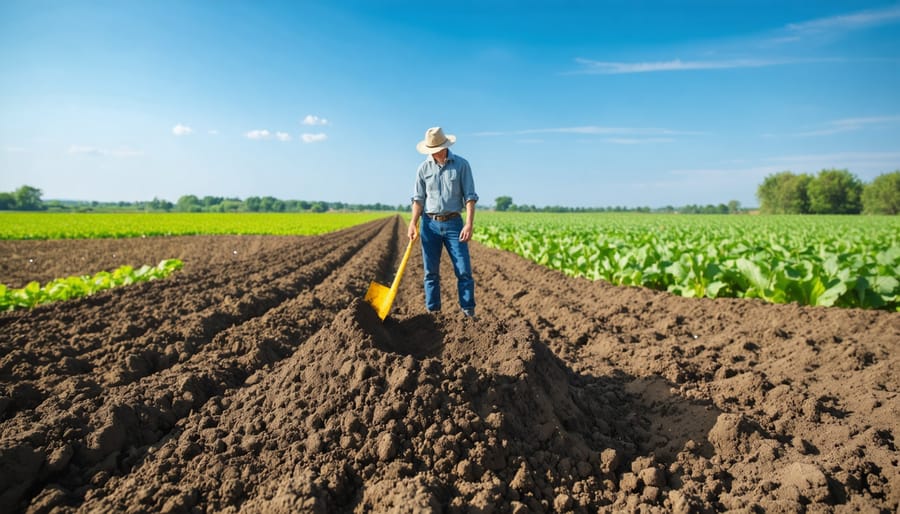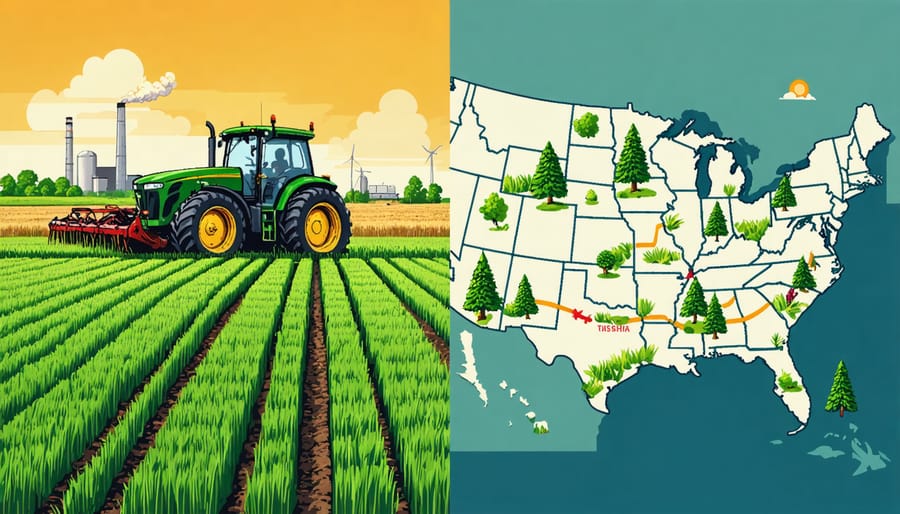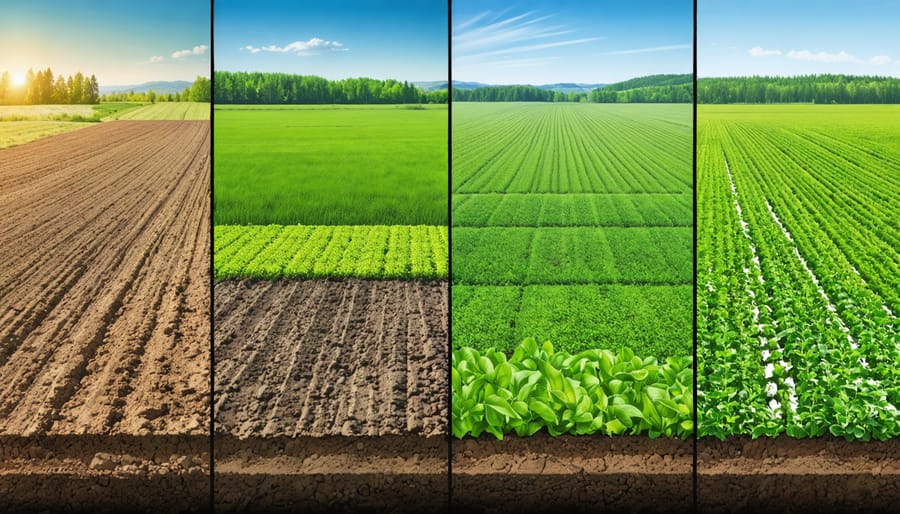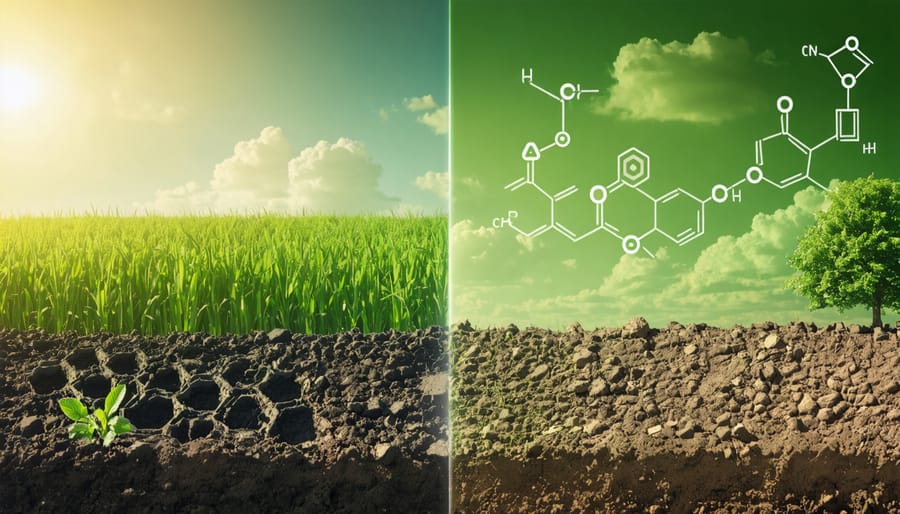Build organic matter rapidly by integrating livestock into crop rotations, creating a closed-loop system where manure enriches fields and crop residues feed animals. Plant diverse cover crop mixtures between main crops, combining deep-rooted species like clover with fibrous-rooted grasses to maximize soil carbon storage at different depths. Minimize tillage operations to protect existing organic matter, focusing on soil health fundamentals that preserve soil structure and beneficial microorganisms. Return all possible organic residues to fields, including straw, chaff, and green manure crops, calculating application rates based on your soil’s current organic matter levels and regional climate conditions.
These proven strategies, adapted specifically for Canadian prairie conditions, create a regenerative cycle that builds lasting soil fertility while improving drought resistance and nutrient cycling. Recent field trials across Alberta demonstrate organic matter increases of 0.5-1% over three years when these methods are implemented systematically, transforming even challenging soils into productive, carbon-rich growing environments.
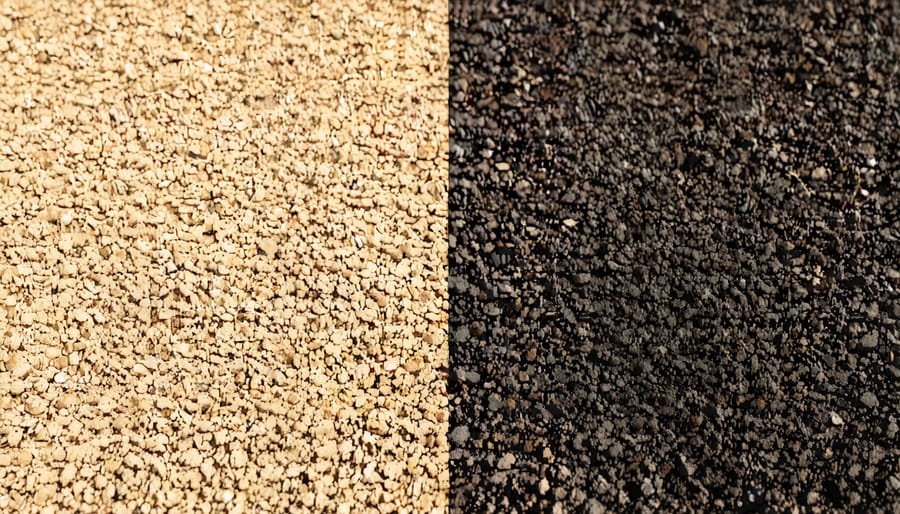
The Prairie Soil Challenge: Understanding Your Starting Point
Reading Your Soil Test Results
When reading your soil test results, pay special attention to the organic matter percentage, which typically ranges from 2% to 10% in Alberta soils. For most agricultural land in our province, a reading between 3% to 6% indicates healthy soil organic matter levels. However, these numbers can vary significantly based on your specific location and soil type.
Many Alberta farmers aim to increase their soil organic matter by 0.1% to 0.2% annually – a realistic and achievable goal. Remember that building organic matter is a gradual process, and even small improvements can have significant impacts on soil health.
Your soil test might also show the carbon-to-nitrogen ratio (C:N), which ideally should be between 10:1 and 12:1. This ratio helps you understand how quickly organic matter will decompose and become available to your crops.
If your results show organic matter levels below 3%, consider this an opportunity rather than a setback. Many successful Alberta farmers have demonstrated that with consistent management practices, significant improvements are possible over a 3-5 year period, even in our challenging prairie climate.
On-Farm Resources: Making the Most of What You Have
Crop Residue Management
Effective managing crop residues is one of the most practical ways to build organic matter in your soil. Here in Alberta, we’ve seen remarkable success stories from farmers who keep their crop residues in the field rather than removing or burning them. The key is to maintain a balanced approach that works with your specific operation and local climate conditions.
Start by leaving at least 30% of crop residues on your fields after harvest. This provides essential ground cover during our harsh prairie winters and helps prevent soil erosion. For cereal crops like wheat and barley, consider using a straw spreader during harvest to distribute residues evenly across your fields.
To speed up decomposition, you can lightly incorporate residues into the top 5-10 cm of soil using shallow tillage in fall or spring. This approach works particularly well in our cooler climate where decomposition rates are naturally slower. Many Alberta farmers have found success using multi-species cover crops alongside residue management, as the living roots help break down crop remains more efficiently.
Remember to monitor your residue levels – too much can interfere with seeding operations, while too little won’t provide adequate organic matter benefits. A good rule of thumb is maintaining about 2-3 tonnes of residue per hectare for optimal results. Consider your soil type and moisture conditions when adjusting these amounts.
Livestock Integration
Integrating livestock into your farming operation can significantly boost soil organic matter through both direct and indirect methods. Manure from cattle, sheep, or poultry provides readily available nutrients and organic materials that feed soil microorganisms. In Alberta’s prairie conditions, well-managed regenerative grazing practices can increase organic matter by up to 2% over five years.
Consider implementing rotational grazing, where livestock are moved frequently between paddocks. This approach allows for optimal manure distribution and prevents overgrazing while promoting root growth and natural nutrient cycling. For best results, maintain grazing heights above 10 centimetres to ensure sufficient plant recovery and root development.
Livestock integration also supports organic matter building through trampling of plant residues. The physical action of hooves helps incorporate organic material into the soil and creates minor surface disturbances that enhance seed-to-soil contact. During winter feeding, strategic placement of bale grazing areas can concentrate nutrients in fields requiring organic matter improvement.
For farmers without their own livestock, partnering with neighboring ranchers can create mutually beneficial arrangements. Custom grazing agreements allow crop farmers to benefit from animal impact while providing valuable feed sources for livestock producers. Remember to test manure before application to understand its nutrient content and optimize distribution rates for your specific soil conditions.
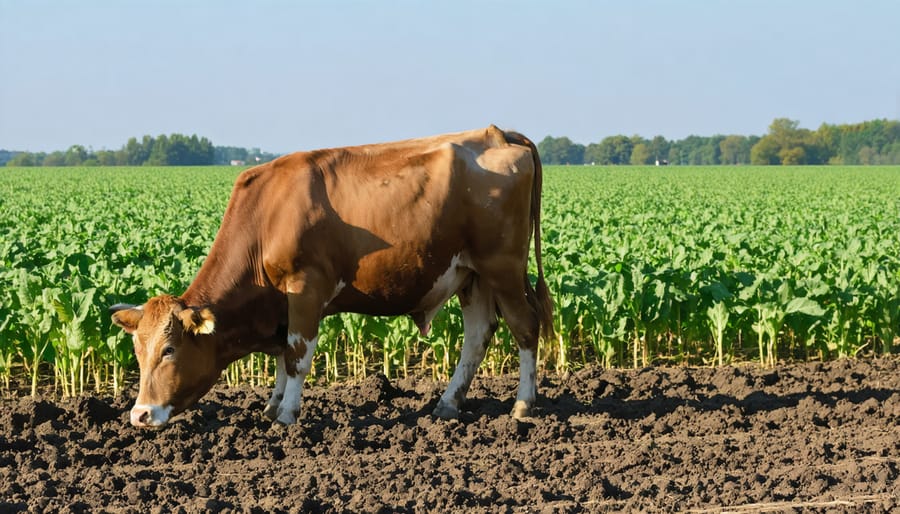
Cover Cropping in the Canadian Climate
Cold-Hardy Cover Crop Options
In Alberta’s challenging climate, selecting the right cover crops for winter survival is crucial. Fall rye stands out as our most reliable option, capable of withstanding temperatures down to -40°C while establishing strong root systems before winter sets in. Winter triticale and winter wheat also perform well, though they require seeding by mid-September for optimal results.
For early spring planting, field peas and hairy vetch are excellent choices that can tolerate light frosts and provide significant biomass by early summer. These legumes offer the added benefit of fixing nitrogen while building organic matter.
Consider timing carefully – seed winter-hardy species between August 15 and September 15 in central Alberta, adjusting about a week earlier for northern regions and later for southern areas. Spring-seeded options should go in as soon as field conditions permit, typically in late April or early May.
For best results, combine multiple species. A popular mix among Alberta farmers includes fall rye with hairy vetch, providing both winter hardiness and nitrogen fixation benefits. This approach maximizes organic matter production while improving soil structure through diverse root systems.
Closing the Loop: Creating Your Farm’s Nutrient Cycle
Composting Systems That Work
On the prairies, successful composting systems need to be both practical and weather-resistant. A three-bin system works well for most farm operations, allowing for active composting, curing, and storage. Each bin should be about 2 metres wide and 1.5 metres high, with one side removable for easy access with farm equipment.
For optimal results, layer your materials using the 30:1 carbon-to-nitrogen ratio rule. Mix readily available farm materials like straw, crop residues, and livestock manure. In our prairie climate, maintaining proper moisture is crucial – aim for the consistency of a wrung-out sponge. During our dry summers, you might need to add water occasionally.
Many Alberta farmers have found success with windrow composting, especially for larger operations. These long, narrow piles typically measure 2-3 metres wide at the base and 1.5 metres high. The key is turning the windrows every few weeks during the warm season to maintain proper aeration and speed up decomposition.
Remember to monitor your pile’s temperature – a probe thermometer should read between 55-65°C in the active phase. In winter, larger piles help maintain heat despite our harsh temperatures.
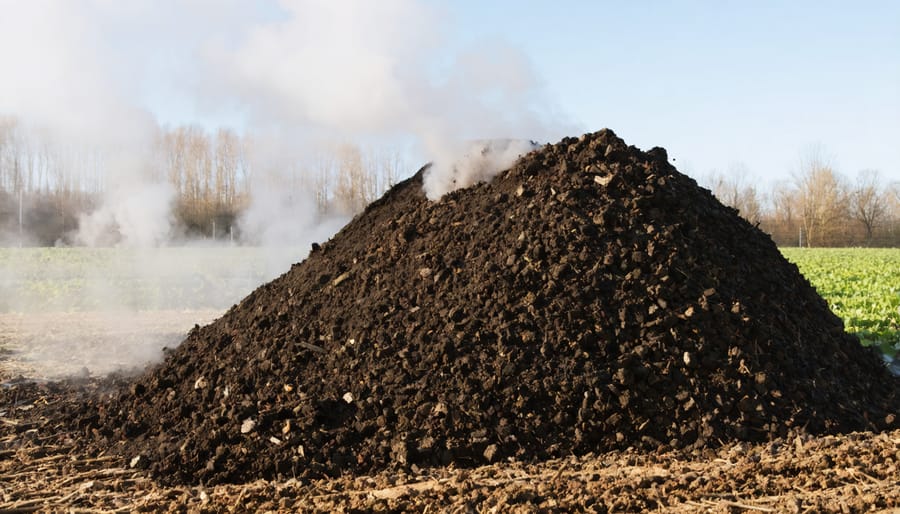
Building soil organic matter is a journey that rewards patience and consistent effort. By implementing strategies like cover cropping, crop rotation, and reduced tillage, you’re not just improving your soil – you’re investing in the future of your farm. Remember that even small changes, like leaving crop residue or adding composted manure, can lead to significant improvements over time. Many Alberta farmers have already seen remarkable results, with some reporting up to 2% increases in organic matter over five years of dedicated management. Start with the practices that best fit your operation, monitor your progress through regular soil testing, and connect with local farming groups to share experiences. Together, we can build healthier, more resilient soils that will sustain Canadian agriculture for generations to come.

